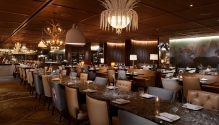A Hotel that Defines the Destination
Kanota was a fabled trade route between Mughal-ruled Agra and Rajput-dominated Jaipur. This fusion of Jaipuri and Italian design languages has been evocatively captured in the interiors of Villa Palladio, which sets a benchmark for contemporary luxury boutique hotels.
By Shalbha Sarda
Kanota, Rajasthan, has become an unexpected hotspot for designers, architects, and fashion photographers these days. Once a bustling route for travellers and traders between two ancient kingdoms—the Mughal court in Agra and the Rajput royals of Jaipur, today it is Villa Palladio, a boutique hotel that has placed the little town on the tourist map. While modern Jaipur boasts no shortage of suave stays, Villa Palladio has a different design game altogether. Villa Palladio marks the third collaborative venture between Swiss expatriate Barbara Miolini and Dutch designer Marie Anne Oudejans. Their creative partnership began in 2010 with the inception of Bar Palladio within the historic Narain Niwas Palace.
The duo’s imaginative blend of vibrant blues inspired by the palace’s peacocks and art from the Veneto countryside has transformed the bar into an Instagram sensation. Originally arriving in Jaipur in 2005 for a sabbatical, Barbara Miolini, a Swiss native, found herself making the Pink City her permanent residence. Meanwhile, Oudejans transitioned from a successful fashion label, Toca, in Paris to the realm of interiors, incorporating commonalities of understanding design basics and trends. Beyond the foreign origins, the duo discovered a deep connection through their shared passion for amalgamation of architectural styles, a mutual fascination with Italian artists, and, most importantly, their shared love for Jaipur, a city that they both now proudly call home.

Villa Palladio has a different design game altogether.
The palette
At first glance, Villa Palladio seems like an oasis on the road, a resting place for weary travellers of ancient days, echoing the charm of a caravanserai. However, the moment you step beyond the innocent-looking white-washed walls from the outside, you find yourself transported to a completely contrasting world within—a world of hues of red! Oudenjans reflects, “In the 1990s when I was doing fashion, we broke many rules with our dresses. It was an incredible time; the world was undergoing a colour renaissance, transitioning from grey, black, and white to a vibrant palette. I found myself in the right place at the right time, and this is reflected in my interior designs.”
Miolini knew pink lingered longer when a tourist headed home from the Pink City of Jaipur. With the villa, she aimed to introduce some bright crimson and the pastel ochre colours that Jaipur is renowned for. She says, “I wanted people to dream here of exotic lands; the colour scheme was all part of the mood boards, and somewhere red kept coming back. Red is sexy and scandalous and stimulates the imaginative fantasy of each person’s own making. However, it could also become overwhelming, and that’s why there are shades and tints of red. The jaunty stripes mix a bit of white and bubble-gum pink in the salon; the chevron patterns and the unusual motifs on the walls offset the 'red effect'.”

Almost all the furniture and decor at Villa Palladio has been locally sourced, including comforters, cushions, rugs and lamps; The bathrooms, an extension of the room aesthetics, defy the sleek trend in modern design, prioritising comfort and cosiness.
The art
Unlike the usual geometric, floral and abstract Mughal motifs, the paintings on the walls of Villa Palladio were deftly borrowed from the Italian countryside, paying homage to Renaissance artists and the time. When the roosters of Medici ceramics, the pomegranates of Botticelli, the Corinthian hibiscus flowers and the palm trees of the grove of Bordighera are superimposed on the Mughal arches, castellated towers, the durg walls, and Rajputi jharokhas, a sense of déjà vu sets in.

Almost all the furniture and decor at Villa Palladio has been locally sourced.
Design philosophy
The beauty of Villa Palladio is that it feels old and new, familiar and unique all at once, as if it were a dream. Miolini thinks that “design should make you dream. You are stepping into an ongoing aesthetics conversation with each of my projects. I love seeing how guests come up with their interpretations and references to our thoughts and how that contributes to each person’s Palladio fantasy.” The original building was constructed in 1960 as a heritage haveli-style structure featuring chhatris, jaalis, jharokhas, and arches. The villa served as the residence of a nobleman of Kanota, Abhay Singh. Was it a challenge to use Italian designs as flesh when the structure is very Indian at its bones? Miolini muses, “Jaipur and Italian designs are much more similar than one would think. Both have been centres of royalty and medieval global luxuries, building a beautiful vocabulary of aesthetics and sophistication when fused.”
History offers many testaments to blending two distinct styles of architectural practices, as seen in the Musée du Louvre in Paris and the Nelson-Atkins Museum of Art in Kansas, exemplifying the narrative of their grandeur. The key lies in understanding that incorporating something new does not necessarily diminish the value of the old but can enhance its sculptural significance. Oudejans cleverly solves the problem by using a reference from Andrea Palladio (1508-1580), a Venetian architect who first showed the world a way to the Renaissance problem of placing a classical facade in front of a basilican cross-section in the 16th century.

Villa Palladio seems like an oasis on the road, a resting place for weary travellers of ancient days, echoing the charm of a caravanserai.
The challenge
The real problem was to keep the design aesthetic rooted to the land it belonged to, for which Oudejans employed local craftsmen. She states, “Simple village people bring my exotic European imagination to life. Almost all the furniture and decor at Villa Palladio has been locally sourced, including comforters, cushions, rugs, and lamps. The metal craftsman we worked with from the neighbouring village created the Beidermeier-style dining chairs for the veranda alongside the Palladio tents. The awnings are similar to those seen in Italian palazzi. It is amazing to see how they have immense design sensibilities and meticulousness. Despite having almost no exposure to the Western world, Villa Palladio achieved precise results. It is incredible that some of them never had the opportunity to attend school. Witnessing the exposure to the world and the joy my modest efforts can provide is the most rewarding aspect of my work.”

The pool house nestles at the garden's end and features a lap pool in black slate with a candy-striped interior, akin to caravan rooms.
The property
Initially concealed by large jaalis, the central hall or the salon offers a slow and intriguing reveal upon entering. The salon is a maximalist space saturated in colour, featuring walls adorned with birds, flowers, and leaves, complemented by glossy red furniture, checkerboard floors, and trellis-patterned details. A striped corridor runs along the perimeter, playing a visually engaging game. Two exquisite oil paintings of horses, banners, and leopards add weight to the design, anchoring the entire space. The property boasts nine rooms, including tower rooms that blend palace elements and a circus-like tent. The exclusive suite boasts a separate living and bedroom adorned with mirrors and opulent vines, evoking a deep crimson Wes Anderson style.
The bathrooms, an extension of the room aesthetics, defy the sleekness trend in modern design, prioritising comfort and cosiness. Marble jaalis for showers and red-and-white marble floors ensure continuity. Oudejans and Miolini embraced diverse lighting, avoiding halogens or track lights. Instead, the property is adorned with things such as hanging lanterns, Venetian wall sconces, and delicate table lamps, creating a homely ambience.
The pool house, nestled at the garden’s end behind hibiscus and date palms, features a lap pool in black slate with a candy-striped interior akin to caravan rooms. Miolini aimed to make Villa Palladio feel like a home, foregoing restaurants in favour of dining rooms.
The concept emphasises the private nature of Villa Palladio, offering a menu designed for casual, homely dining, featuring lavish breakfasts, light lunches, poolside delights, and dinner pairings, showcasing classic Italian fare. The breakfast veranda exudes Indian aesthetics, while the garden veranda pays homage to Palermo, combining chevrons from 10th-century Norman-Arab architecture with whimsical vintage beach club décor.

The beauty of Villa Palladio is that it feels old and new, familiar and unique all at once.
The city and the villa
In a world where cities such as Jaipur risk losing the artisanal quality of centuries-old architectural practices, Villa Palladio stands as a vibrant design lesson. While the cityscape may boast beauty, it often treads the path of familiarity, reluctant to embrace experimentation within its prebuilt heritage structures. Villa Palladio challenges this norm, reminding us that the past holds valuable lessons—the awe-inspiring ingenuity of Hawa Mahal, the theatrical spectacle of painting Jaipur in pink, and liberating the creativity of our ancient architects. Villa Palladio effortlessly does that; it strays boldly from the regular designs and intertwines Italian Renaissance exuberance with the decadence of Maharajas, equally at home in Italy and India, swaying you every minute between the two countries.

The suite boasts a living room and a bedroom adorned with mirrors and opulent vines, evoking a deep crimson Wes Anderson style.


























